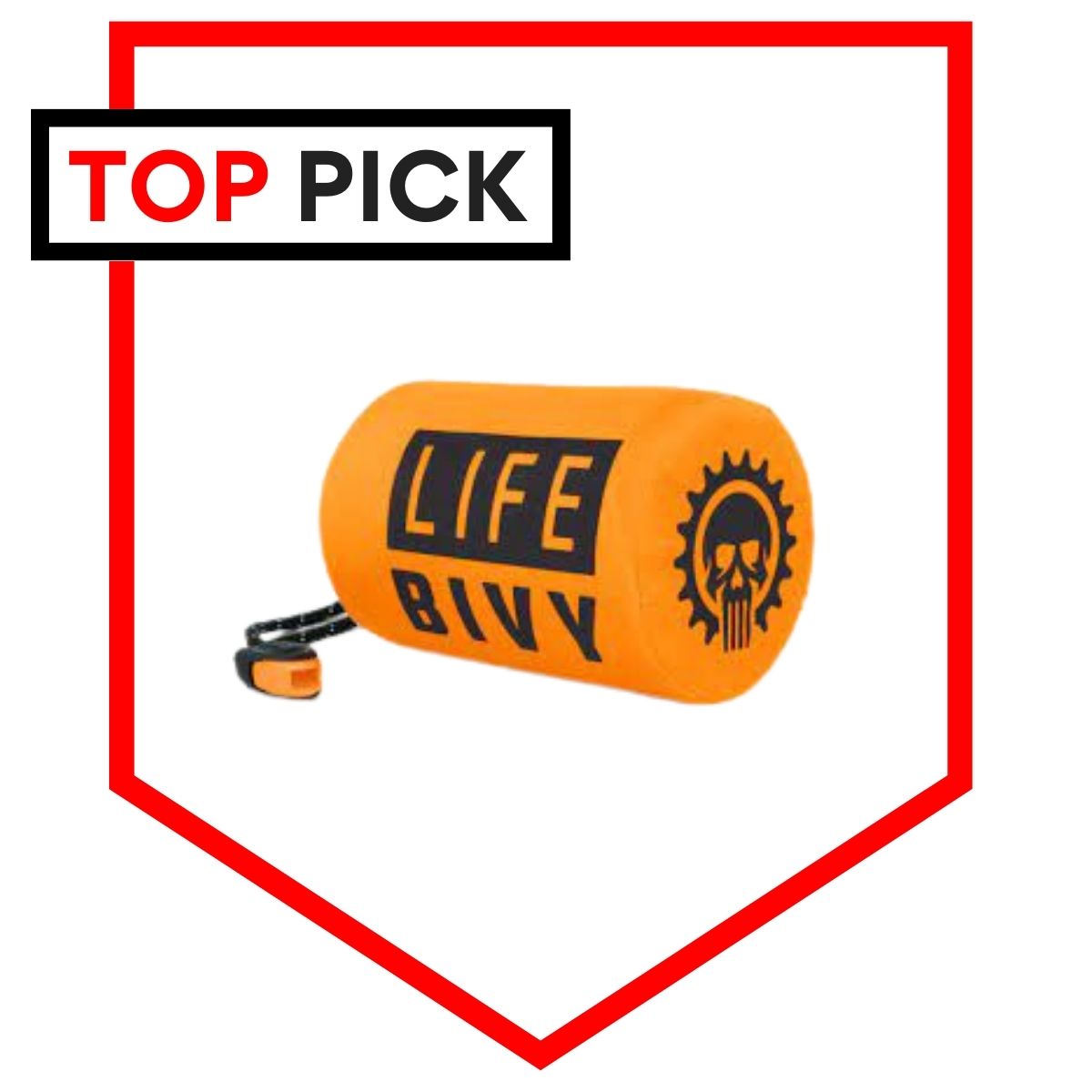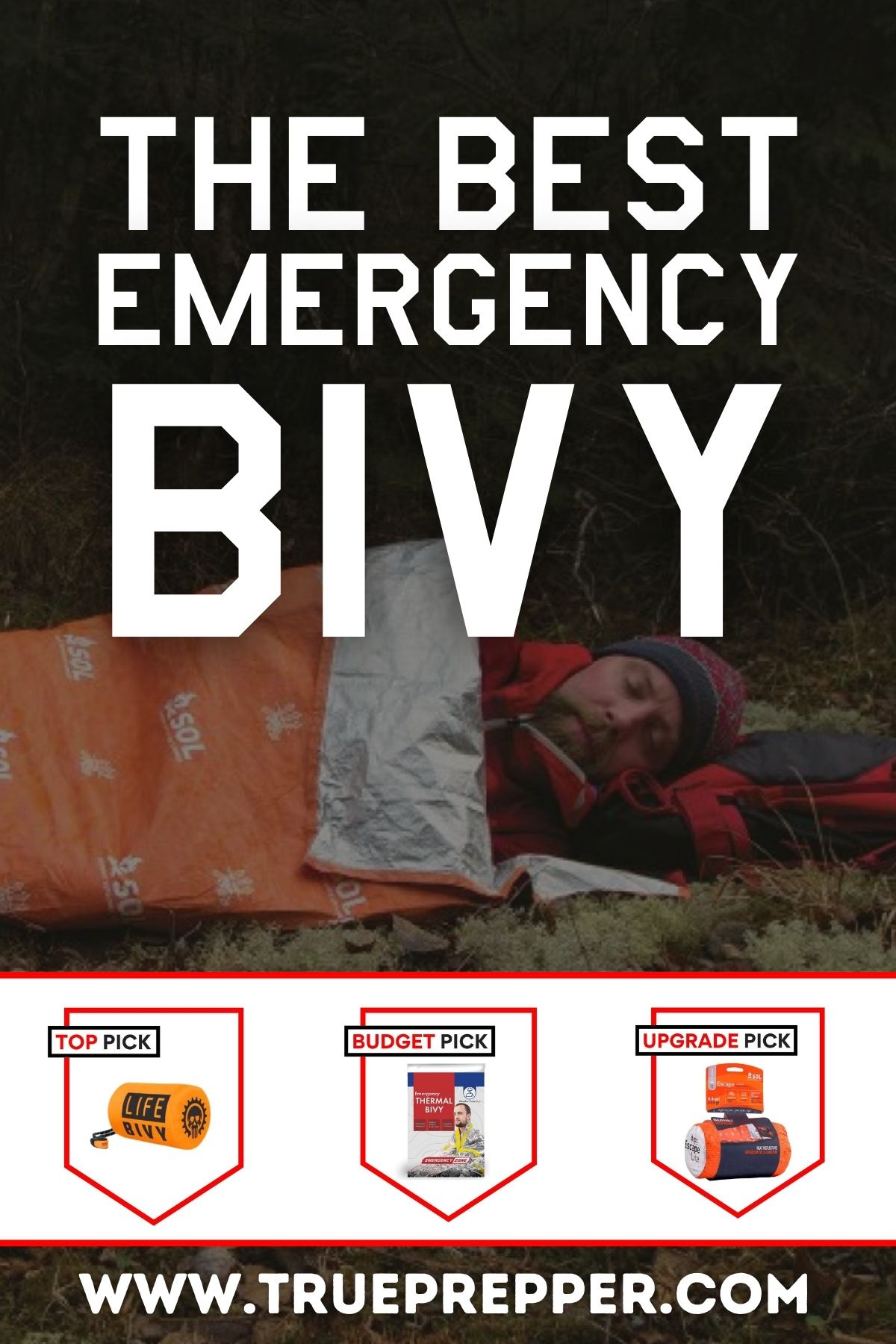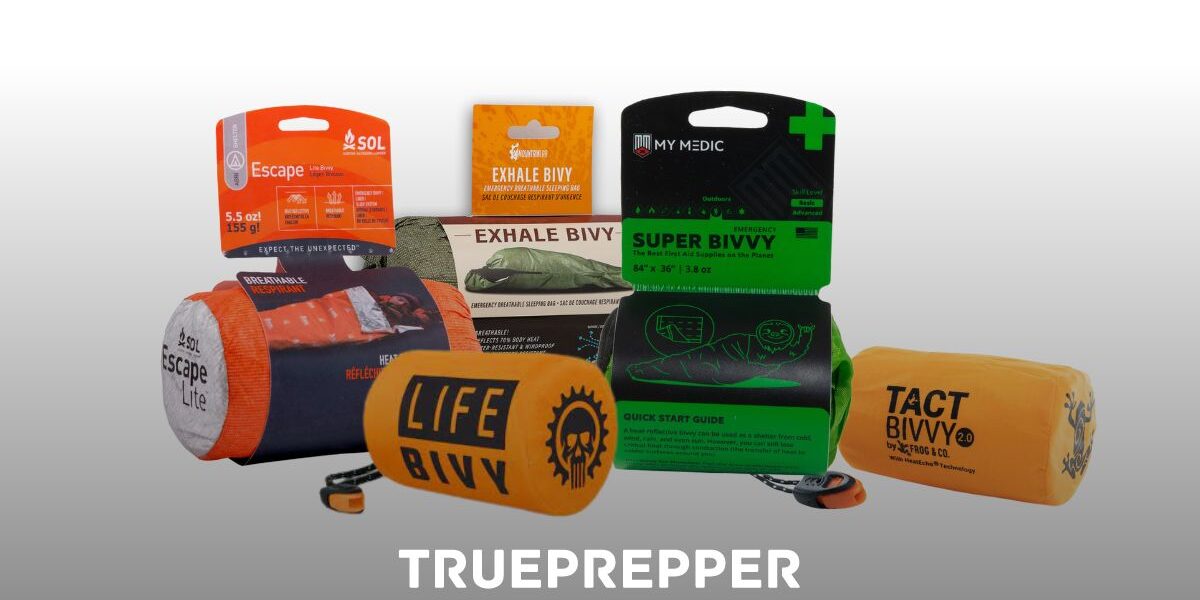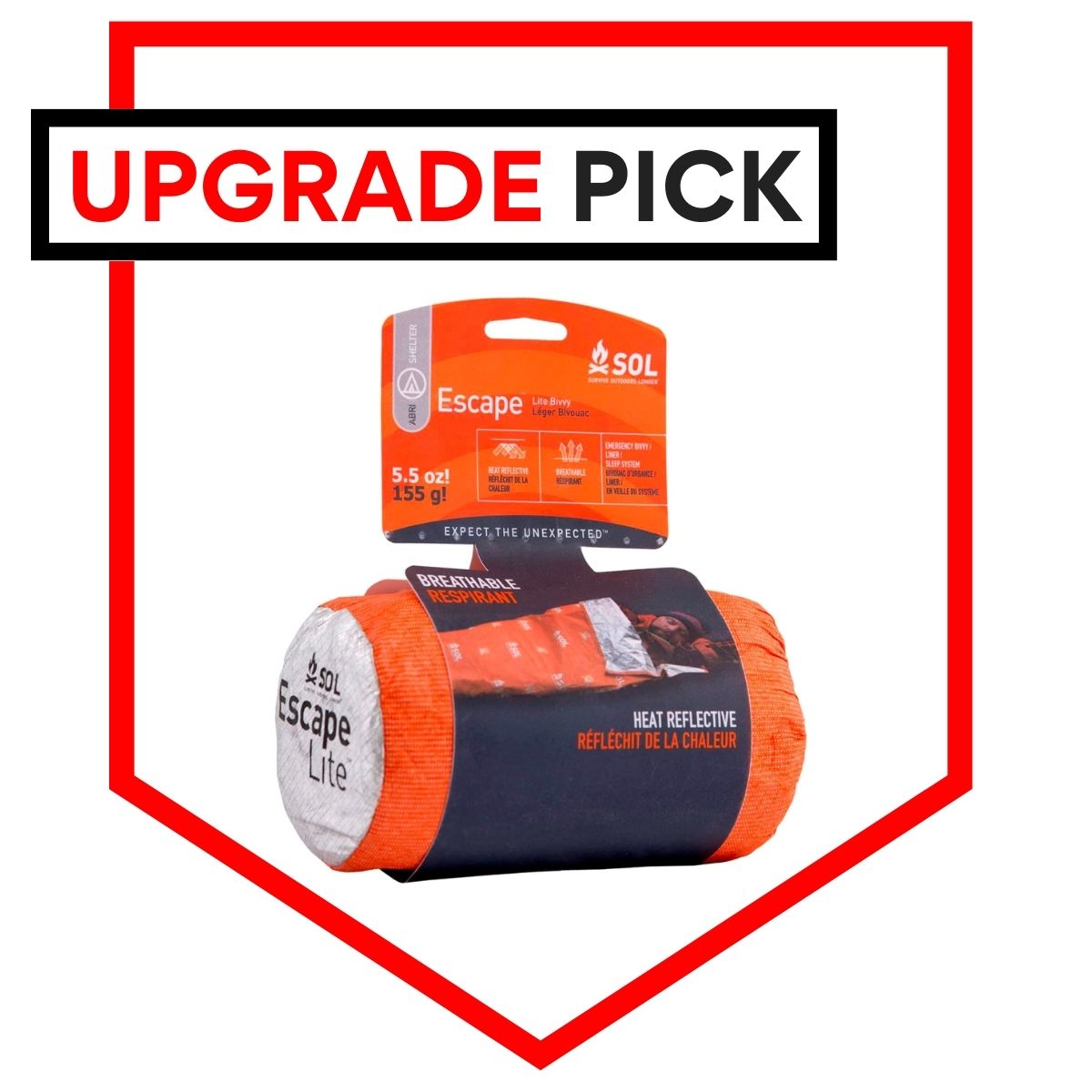Best Emergency Bivy Sack for Survival Emergencies
It’s more than an emergency blanket and less than a camping bivouac tent: it’s the emergency bivy sack. And it’s meant to save your life. They are a relatively cheap form of shelter, and the best emergency bivy sack can make all the difference when you need it most. There are a lot of options to consider when it comes to emergency bivies: size, weight, thermal retention, etc.
This is where we come in. We’ve researched the best emergency bivys, tested them, and now the results are in: the overall best, a budget option, and an upgrade option. If you need a bivy to put in the survival kit that you can count on, one of our picks will keep you covered.
Contents (Jump to a Section)
The Best Emergency Bivy
Life Bivy
Lightweight, Warm, and Versatile
This bivy edges out the competition by being slightly lighter and being a great value at a low price.
*Price at time of publishing; check for price changes or sales.
There are a lot of options in this price range and construction type, but this one from Go Time Gear edges them out. It is slightly more lightweight and comes at a lower price. It still has plenty of thermal retention and better-than-expected durability.
Most of these models that are similar have the emergency whistle built-in, but a standalone survival whistle is usually a much better option anyway.
Here is how it measures up:
- 4 color options
- PET, mylar construction
- Waterproof, windproof
- 14 F temperature rating
- 90% heat reflective
- 36″ W x 84″ L
- 4.1 ounces
With unsurpassed value, it’s easy to see why Life Bivy is the best.
Budget Emergency Bivy
Thermal Bivy
Inexpensive, Effective, and Lightweight
This cheap option (especially in bulk) checks all the boxes without breaking any budgets.
*Price at time of publishing; check for price changes or sales.
These are about as basic as you can get, but they work. It’s pretty much just a mylar blanket taped up to form a bag but it is cheap and effective.
Another great thing is that you can get these in bulk quantities. Get them for under $3 each if you are stocking up for your community or want even more for your kits. Because they are small, cheap, and lightweight there is not really any reason to exclude them from any survival kit you are building.
Here are the full specs:
- PET, mylar construction
- Waterproof, windproof
- 36″ W x 84″ L
- 3.7 ounces
If you are looking for a budget bivy or to buy in bulk, you can’t go wrong with an Emergency Zone Thermal Bivy.
Upgrade Emergency Bivy
SOL Escape
Lightweight, Breathable, and Warm
The lightest-weight breathable option is an upgrade shelter solution for any survival kit.
*Price at time of publishing; check for price changes or sales.
One of the biggest drawbacks to conventional mylar blankets and bivies is that they are not breathable. This is problematic because they retain a lot of heat, which can make you sweat. You don’t want to get wet, so breathability becomes a great feature to have in a bivy.
Most bivies with breathable fabric are larger and heavier, so this is where the Escape excels. It meets the sweet spot between emergency bivies and expensive ultralight bivies to give us an option that won’t keep us sweating in an emergency.
Here are the details:
- PET, mylar construction
- Waterproof, windproof, breathable
- 14 F temperature rating
- 70% heat reflective
- 31″ W x 84″ L
- 8.5 ounces
If you are looking for the best of the best, pick up an SOL Escape Bivy.
Everything We Recommend

This bivy edges out the competition by being slightly lighter and being a great value at a low price.
Where to Buy
*at time of reviewing

This cheap option (especially in bulk) checks all the boxes without breaking any budgets.
Where to Buy
*at time of reviewing
The Bivy Sacks We Compared
Our research narrowed the field down to several types and brands of bivies that we compared: SOL, Life Bivy, Ironstripe, MyMedic, Exhale, Delmera, and more.
You can see our full list of review criteria below in the What to Look For section, with an explanation for each.
We considered a wide range of bivvies but quickly ruled out traditional backpacking and ultralight bivvies due to their cost and size. Emergency bivvies usually came up as lighter options at a much lower cost, albeit with lower durability.
We’re always looking for new and better equipment, so if you have an emergency bivvy that has been your go-to for a while, let us know in the comments. We review most of our tested equipment annually, so we can always get it in the next roundup round and see if it makes the cut and we can see if it will beat out our top picks.
What to Look For
The best emergency bivy has several important features to look for that set it apart:
- Value
- Thermal Retention
- Versatility
- Size & Weight
- Quality
When you get the right blend of these, you can find a cheap shelter sack that will work perfectly for your survival kits. Below, we break down what each of these features means for the bivies that truly set themselves apart.
Value: Cost vs. Benefit
The amount of money you spend on something like a bivy shouldn’t blow out your entire budget. There are some really nice options out there for ultralight backpackers but it’s overkill for most people’s emergency kits.
You never want to spend too much money on one piece of gear. It’s better to diversify your preparedness gear to make sure you are covered for a wide range of scenarios.
Thermal Retention
The point of a bivy in an emergency is to provide shelter to your body by keeping you covered and warm. Emergency bivies do this by reflecting body heat, usually with mylar. Traditional bivies do this with insulation which is much more breathable but also bulkier.
Some emergency bivies are temperature-rated, which can help in your comparison. They will also rate the thermal retention by a percentage of body heat retained, usually between 70% and 90%.
Versatility
There are many ways to use an emergency bivy on its own, but a few manufacturers offer extra versatility.
Some include emergency whistles on the drawstring lanyard. The whistles aren’t great, but not bad to have around as a backup since we all know two is one and one is none. Most also come with a stow bag. It can be difficult getting the bivy back into it once you use it but it is possible. You can also use the bag as a gathering pouch or whatever else you can come up with.
Size & Weight
Emergency bivies still weigh half the weight of a top-of-the-line ultralight backpacking bivy and they compact down to over half of the packed size. Not to mention, they are cheaper by a magnitude of about 10.
In mobile survival kits, every ounce matters, and that’s why the low weight and small size of an emergency bivy fits so well.
Quality
They may seem simple at first, but a manufacturer’s attention to detail is important in any type of survival gear. It starts with material selection- mylar is available in different ‘mil’ thicknesses, which can affect durability and weight. Sometimes it is laminated onto another surface, like PET.
The lamination and the seaming are a few of the areas where some manufacturers struggle. If you go with our budget pick or any other cheaper bivy than our top pick, we recommend checking out the seam quality and construction before you field it in your survival kit.
How to Use an Emergency Bivy Sack
Use an emergency bivy to give you an impromptu shelter by:
- Find a location: Look for a spot that is sheltered from the wind, rain, and other elements. Try to find a flat, dry surface to set up your bivy if at all possible. Don’t set up under dead limps (deadfall).
- Unfold the bivy: They come folded up about a hundred times, so shake it out and find the opening.
- Get in the bivy: Open the bivy and crawl inside, with your head at the opening of the bivy and your feet at the bottom. If there is a shiny side, it should be facing inward, towards your body.
- Seal the bivy: Close the bivy around you as much as possible, leaving only a small opening for breathing. If the weather is particularly cold, windy, or wet, use tape, cord, or other materials to seal the bivy and prevent drafts.
- Stay warm: The reflective surface of the emergency bivy will help trap your body heat and keep you warm. Regardless, it’s still important to wear warm winter clothing, including a hat and gloves, to stay as warm as possible.
Remember that an emergency bivy is designed for short-term use only, and is not durable enough to use as a long-term shelter.
As Marty shows below, you don’t want to rely on any bivy past its temperature limits:
Who Needs an Emergency Bivy Sack?
An emergency bivy sack is something you’ll find in most survival kits. They are lightweight and relatively cheap so they fit in any configuration.
We consider a survival bivy essential for your:
We also suggest you consider adding it to your:
An emergency bivy can come in handy anywhere, even if you just need to warm up (like at a sporting event).
How We Review Products: We research thoroughly before selecting the best products to review. We have vast prepping and survival experience and bring in outside experts when needed. Hours on end are spent testing gear in stressful conditions and using specialized testing gear to verify claims. We assign performance criteria and impartially rate each tested item. Learn more about how we test.
Sources and References
All of our experience and the testing we do to determine the best emergency bivy sack is useless without listing our research sources and references. We leaned on these for the book knowledge that we paired with our hands-on testing and practical military and prepping experience:
Worly, G. (2011). Personal Survival Kits. Journal of Earthquake Engineering. Volume 30. Issue 5. Pages 264-269. (Source)
Morton, P. (2004). Wilderness survival. Emergency Medical Clinics. Volume 22. Issue 2. Pages 475-509. (Source)
Larabee, M. (2015). The things we carry PCTA’S BACKPACKING CHECKLIST. Pacific Crest Trail Association. (Source)
The Final Word
Shelter is one of the first survival priorities, and a bivy will help you meet it quicker than anything. Emergency bivies may be meant for single use, but that one use could save your life. Plus, many of the ones we tested were reusable even if they aren’t the most durable sleeping bag on the market.
Here are a few other reads our subscribers have also found helpful:
- The Best Survival Water Filter | Portable and Stationary
- The Best Ferro Rod for Survival Fire Starting
- Bug Out Bag List | 44 Essentials
We presented quite a lot of information, but as always: if you have any questions let us know and we would be happy to help. Our research and testing found the Life Bivy to be the best option given its value, thermal retention, versatility, profile, and manufacturing quality.
Keep exploring, stay prepared, and be safe.
You’ve Been Missing Out
Join the 2+ million preppers that rely on our prepping advice by subscribing to TruePrepper.- Practical guides and tips
- Useful survival giveaways
- Free, forever
- < 0.4% of people unsubscribe




Sean,
I created the Outdoor Designs USA bivy about 5 years ago. I am selling the remaining inventory that I have. Would you be interested in this or know someone who might? I have about 1100 units.
Thanks! Andy